Adaptive damping
Ferrari and Maserati are
the
keenest users of adaptive damping. The former's Mondial T, F355, 456GT,
550M, 360M and the latter's Shamal, Quattroporte and 3200GT all
employed
electronic adjustable dampers in the suspensions. In most of the time,
the damper is in "soft" setting to benefit ride comfort. In case the
car
goes in action, it is set to "stiff" mode for stable handling and
minimize
body roll.
The mechanism is
usually
very simple. By varying the total area of valves area within the shock
absorber, different rate of damping can be obtained. Therefore the
shock
absorber alone is able to implement the adaptive damping.
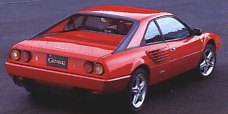 |
Ferrari
Mondial T - the
earliest Ferrari to have adaptive damping. |
Ferrari's earliest
system was
launched in Mondial T. It required the driver to select the rate of
damping
among 3 settings - soft, intermediate and hard. Later, in 456GT and
F355's
systems, computer decided the setting automatically. Sensors were
employed
to measure the longitudinal acceleration, lateral acceleration, speed,
brake pressure, load and steering angle. Via analysing these data, the
computer knew the driver's intention - to go fast or to travel
leisurely.
Then decide the most suitable damper setting.
It looks great, but
the effectiveness
is quite limited. Firstly, it can just vary the damping rate, not the
spring
rate and anti-roll bar function. Secondly, individual wheel or axle
cannot
be set according to need. All four wheels always run on the same
damping
setting. Thirdly, it seems that until now all the designs still react
slowly,
therefore they are employed to deal with the changing driving style
(which
is more consistent) rather than the change of road condition (which is
fast-changing and unpredictable).
Semi-Active Suspension
Citroen XM's Hydractive
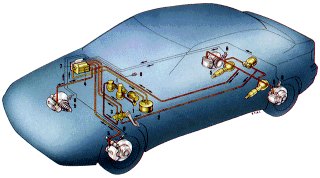 |
XM's
Hydractive system.
Note that there are totally 3 spheres in the rear axle. All the
suspensions
are interconnected with high-pressure hydraulic which is supplied by
the
engine-driven pump. The front spheres are not shown in this
picture. |
Unlike adaptive damping,
Citroen's
famous Hydractive suspension is fast-reacting, can vary individual
axles'
spring rate and damping rate. Let's see how it works:
The Hydractive, which
appeared
in the XM as optional equipment since 1989, was based on the company's
traditional "Hydropneumatic suspension". The latter has a large sphere
at the top of each shock absorber. Within the sphere there are 2
compartments
filling with compressed air and high-pressure fluid respectively,
separated
by an elastic barrier. The gas acts as conventional suspensions' spring
while the fluid acts as damper. Shock from the wheel transmit via the
fluid
into the elastic barrier, than compress into the gas compartment. The
gas
absorbs the energy and release back to the fluid, which smooth the
reaction
by its damping effect. Remember, in the "Hydropneumatic suspension"
there
is no spring and damper. The sphere does the jobs of both.
Now comes to the
sophisticated
Hydractive suspension. It still employs the spheres at each corner, but
added with an extra sphere (central sphere) at each of the axles,
linking
by fluid between the spheres at left and right wheel. The front and
rear
central spheres also link each other. In other words, the front and
rear,
left and right suspensions are all interconnected by high-pressure
fluid.
With the addition of
central
spheres, the total volume of gas and fluid increases. Therefore the
suspension
can provide softer spring and damping rate that requires by comfortable
ride. Moreover, like the conventional Hydropneumatic suspension, the
fluid
can flow from one wheel to another, one axle to another, thus further
smoothen
the ride.
When the car need
stable
handling and roll resistance, valves in the central spheres close, thus
isolating the wheel's spheres. As the volume of gas and fluid has been
reduced, stiffer spring and damping rate are obtained.
The setting is not
just bounded
to "soft" and "hard" only, since there are many valves associated in
the
central spheres. The more valves close, the stiffer the suspension
becomes.
In fact, Citroen added more valves to the Hydractive 2 system in 1993
in
order to create more level of setting and smoother transition between
soft
and hard.
What made the
Hydractive
so effective is its fast-reacting brainpower. Powerful computer
analysis
the data acquired by speed, g-force, throttle, brakes and gearbox
sensors,
then decide the most suitable setting and activate the valves via
solenoid
and sophisticate power electronics.
Because the
energisation
of the solenoid valves takes as long as half a second while
de-energisation
need merely 2 milliseconds, Citroen use the de-energisation to actuate
the closure of valves, thus making the change from soft to hard setting
far quicker than vice versa. This is very logical, as we always need
stiff
suspensions as soon as we start driving hard. We don't need to enjoy
comfortable
ride as soon as we ease off the throttle.
Citroen Xantia's Hydractive 2 ( Activa
)
Citroen C5's Hydractive 3
The third generation of
Hydractive
suspension is relatively simple to explain. The system, introduced in
C5
in early 2001, was a refinement of the previous generation. Unlike
Activa
(Hydractive 2), it does not have the active anti-roll bar which was
criticized
by some as feeling unnatural. Instead, it added variable ride height
function,
which is easily to implement in hydraulic suspension. By adding or
removing
fluid in the suspension, ride height can be varied. At speed, ride
height
will be decreased to reduce aerodynamic drag and improve stability. By
lowering the front end a few mm more than the rear also introduce some
more downforce (well, may be less lift). At low speed, ride height will
be increased to provide more bump travel and avoid contacting with
ground
obstacle. Off road at really low speed the ride height will be adjusted
to maximum.
The best of the
Hydractive
3, however, is the recalibration of the software system to provide
firmer
yet smoother cornering without the nervous reaction of the previous
generations.
Moreover, by reshaping the gas-fluid spheres, the system becomes more
durable,
without needing maintenance until 200,000 km or 5 years.
As before,
electronics sensors
monitor steering action, brake pedal pressure, engine speed etc. to
know
the driver's driving style. If it sense a leisure driving style,
electromagnetic
valves will be opened thus link the center sphere of each axle with
left
and right suspension spheres, hence increasing volume of gas and fluid
thus provides softer spring and damping rate. In contrast, for sporty
driving
style the center sphere will be isolated from suspension spheres thus
increase
spring and damping rate, providing a firmer ride and better body
control.
Active Roll Control
Citroen Xantia's Activa
 |
Xantia
Activa has even
more spheres. Note the additional sphere incorporated in the front
anti-roll
bar. |
Compare with XM's
Hydractive
suspension, Xantia's Activa system has an additional anti-roll function.
Hydractive reduce
body roll
by stiffening the spring and damper in the price of ride. If it could
stiffen
the suspensions to as hard as Formula One racing cars, it would have
achieve
near-zero body roll under hard cornering. However, because we need an
acceptable
level of ride comfort in a road car, we cannot do that. Therefore
Citroen
developed the active anti-roll bar, added it to the Hydractive and
becomes
Xantia's Activa system.
Based on the
Hydractive,
Activa incorporates a gas-filled sphere in the middle of the anti-roll
bar. The anti-roll bar is unusually thick at a diameter of 28 mm up
front
and 25 mm at the rear. The sphere acts as a cushion, thus allows the
anti-roll
bar to be twisted more easily. Therefore, the 28 mm anti-roll bar
actually
performs like a 23 mm one, thus offer less anti-roll function for
normal
drive.
When the car goes
into a
corner quickly, computer detects body roll thus close the valves in the
sphere. This isolate the gas in the sphere thus eliminate the cushion
effect.
The anti-roll bar thus resume its original stiffness, acting exactly as
a 28 mm anti-roll bar.
It doesn't end here.
If the
lateral acceleration is so strong that body roll continues to exceed
0.5
degree, fluid will be fed into 2 hydraulic rams at the front and rear
which
adjust the anti-roll bars to keep cornering level.
At any time, Xantia
Activa
rolls at most half a degree. This make it not only spectacular to look
at, but also improve cornering speed. French magazine L'Automobile
tested
a Xantia Activa on skidpad and measured an amazing 0.94 g lateral
acceleration.
This compares competitively with many supercars - NSX managed 0.93 g,
Ferrari
512TR 0.92 g, Toyota Supra 0.95 g and Ferrari F40's 1.01 g. This is
even
more impressive if you consider the Xantia wears just 205/55R15 tyres !
Most cars in its class manage around 0.8 g only !
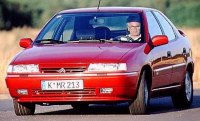 <<
Xantia Activa cornering without roll
<<
Xantia Activa cornering without roll
Mercedes' Active Body Control
(ABC)
Compare with
Citroen’s Activa,
Mercedes’ ABC (Active Body Control) seems rather simple. ABC is a
purely
active roll control device. It can vary spring rate but not damping,
unlike
Citroen’s Hydractive or Activa. Therefore it is not classified as
semi-active
suspension. However, the application in the new CL coupe demonstrate it
helps achieving a stable and fluent cornering. It also saves the need
of
anti-roll bar.
 New CL
with ABC versus
old CL
New CL
with ABC versus
old CL
The mechanical is
quite
simple. Each of the four wheels rides on a thick strut which
incorporate
both spring and damper into a single unit. The damper is in the core of
the strut, surrounding by the coil spring which is topped by a fluid
chamber.
When the chamber is fully filled with fluid (supplied from hydraulic
pump),
the spring is pushed towards the wheel and compressed, thus resist body
roll. On the contrary, if the fluid chamber is emptied, the spring will
be released towards the top of the strut, thus become softer.
ABC is not very
fast-reacting
- the maximum frequency of change is just 5 Hz, because the filling of
fluid takes time - but that’s more than enough for dealing with body
roll.
|
 |
Lotus' fully active
suspension
Unquestionably, active
suspension
is the most ideal suspension. A true active suspension has
double-acting
hydraulic actuator instead of springs and dampers. As tyres meets bump,
the wheel's acceleration and vertical load is transmitted to a computer
which calculates the required wheel velocity and displacement and sends
control signal to the actuator. As the dialogue is conducted hundreds
of
times a second, the wheel accurately follows the contour of a bump,
thus
protecting the body structure against unwanted forces.
When riding on a
bump, Active
suspension, Hydractive suspension and Adaptive damping react very
differently.
The following explain how they "think":
Adaptive damping : "A
shock
encountered ! Another shock ! Again another .... Oh, it seems that the
car is running slowly on bumpy road, let me change the damping rate to
soft setting."
Hydractive suspension
: "A
shock encountered ! I must be riding on a bump. As the car is running
slowly,
I must change the suspension to soft-intermediate setting .... OK, I've
changed .... Oh, the body still accelerating upward ! This means the
suspension
is still too hard. I should have changed to soft setting ! It's too
late.
The bump has already been passed."
Active suspension :
"A shock
is encountered ! I start riding on a bump. Vertical acceleration sensor
and speed sensor tells me the bump is quite high. OK, signal the wheel
actuator to compress 10 mm progressively .... sensors tell me it's not
enough. Well, this time compress another 8 mm and see what's going on
....
6 mm this time .... 4 more mm .... 3 .... 2 .... 1 .... Wow ! I am
riding
on the peak right now ! Start releasing the actuator for 1 mm .... 2 mm
.... 4 mm .... 7 mm .... 10 mm .... Return to flat ground ! Well done !"
As you can see,
active suspension
is simply a perfect concept. Theoretically it could absorb all the
shock
while maintaining the car body stable. Engineers dreamed for it long
ago,
but it was Lotus that put it into reality.
Lotus started
researching
active suspension in 1981, originally intended to equip its Formula One
racing cars. The active F1 ran in Brazil and Long Beach '83 in the
hands
of Nigel Mansell. Despite of lacking competitiveness, it proved that
active
suspension could withstand hard use at 180 mph and 3 g lateral
acceleration.
The development team went back to drawing board and did more test to
improve
the software. It was not raced again until 1987, when the Honda-powered
99T won 3 races in the hands of Ayrton Senna.
However, the active
suspension
did not offer sufficient advantage in F1 racing. Theoretically, it
could
raise cornering speed considerably. ("Cornering at 200mph" used to Team
Lotus's slogan when defending this technology.) But on the down side,
its
hydraulic pump consumed horsepowers. I don't have the exact figure, but
years later Lotus told us the active suspension in its Excel
development
car consumed 4 - 4.5 hp on smooth road and up to 9 hp on rough road.
Worst
of all, Team Lotus did not get specially developed tyres to extract its
potential. As the active suspension reduced tyre's slip angle, the
tyres
generated insufficient heat to attain the necessary working temperature.
Just after the F1
debut in
the 1983 season, Lotus Engineering started developing the active
suspension
technology for production car use. It used the Esprit as the
development
platform. Like the racing car, the hardware - hydraulic actuators -
came
from aerospace industry, where active suspension was used in advanced
jet
engines. According to the engineers involved, the most crucial part was
the software rather than hardware. They had to road test a lot to
acquire
the necessary data in order to write the program.
The first 2
generations were
springless, but the Mk III and Mk IV system, which were equipped in the
Excel development cars, had springs as back up in case the active
system
break. The software was gradually improved. British magazine Fastlane
tested
them twice, once in the '87 Mk III and then in the Mk IV two years
later.
In the latter it reported significant improvement in ride quality and
body
control. It also expressed full optimistic that the system would go
into
mass production within a few years, probably under the name Volvo,
Chevrolet
or Mercedes-Benz, as they all had been consulting Lotus.
This did not come
true. Until
today I haven't seen any sign that car makers are going to put a fully
active suspension into production. The main reasons, I guess, are
likely
to be cost, power consumption and reliability. The only successful
application
was still in motor racing - between 1992 and 1994, F1 championship were
dominated by the active Williams and Benetton. Meanwhile, DTM series
also
saw active suspension's superiority in Mercedes C-class and Opel
Calibra.
Perhaps it was too superior, FIA eventually banned it.
The last time I heard
Active
suspension was in 1995 (?), when Lotus showed the Esprit SDIII
development
car. After that, the automotive world seems to have forgotten the most
ideal suspension ever appeared.
Some people was
misled by
Nissan Infiniti Q45a of 1990. Nissan called the car's suspension as
"Fully
Active" but that was actually a lie. It was just an adaptive damping,
with
conventional coil springs taking care of compression and an hydraulic
device
dealing with rebound.
Tenneco Kinetic Suspension, e.g. McLaren PCC
Tenneco Kinetic suspension is brought to the world's
attention by McLaren MP4-12C, on which the system is called PCC
(Proactive Chassis Control). The latter is the technology's first
application on production performance cars. It shows an amazing
combination of smooth ride and excellent body control. Here we are
going to see how it works.
The Kinetic suspension was invented by Australian engineer Chris
Heyring. American component maker Tenneco acquired its patent in the
late 1990s and developed it for production. Early adoptors include
Citroen C4 rally car (before WRC banned the tech) and Lexus GX470 SUV.
This suspension utilizes hydraulic and gas pressure to provide active
anti-roll function, saving the need for conventional anti-roll bars
thus improving ride comfort. It may also provide adaptive damping,
therefore it is regarded as semi-active suspension.
The hardware of Kinetic suspension looks similar to Citroen's
Hydractive suspensions, but it differs in details and principles. In
place of conventional dampers are four hydraulic cylinders, each
contains a compression chamber and an expansion chamber. They are
interconnected in a way that the compression chambers on the right
wheels link to the expansion chambers on the left wheels, vice versa.
Besides, front and rear wheels are connected. The picture below should
give you a clear idea:
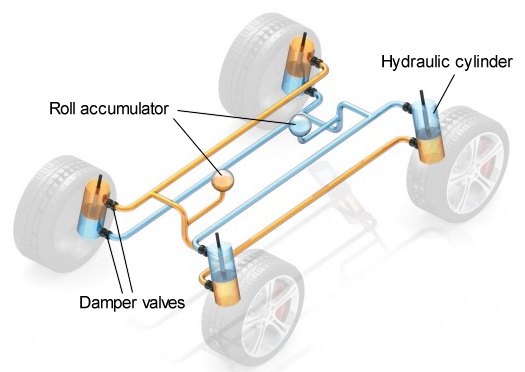
There are two "roll
accumulators", each locate at one of the hydraulic circuit. The
accumulator contains oil (from the circuit) and pressurized gas,
separating by a flexible membrane (like Citroen's suspensions).
Electronic control unit can vary the gas pressure. If it pumps more gas
into the accumulator, more oil will be pushed back to the circuit. If
it releases gas pressure, more oil will be allowed to flow into the
accumulator.
Now see my exclusive illustration below. In case the car steers quickly
to one side, centrifugal force is built up at the opposite side,
leading to body roll. As a result, the inside wheel dips and the
outside wheel compresses. This leads to the orange circuit attains
increased pressure from both cylinders, driving more oil into
accumulator A. On the contrary, the blue circuit attains reduced
pressure from both sides, therefore oil flows from accumulator B to
both cylinders.
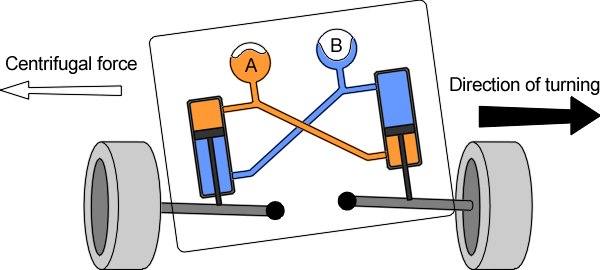
Now, if we increase the gas
pressure in accumulator A, oil will be pushed back to the cylinders,
pressing down the outside wheel and lifting up the inside wheel, thus
eliminating body roll. The higher gas pressure injected, the stronger
it resists body roll. As you can see, each roll accumulator is
resonsible for regulating body roll to one direction.
What if the car is not cornering, but hitting a bump on the road ? Oil
from the compressed wheel will flow towards other wheels, thus the
suspension absorbs the bump comfortably. In contrast, conventional
suspensions with anti-roll bars always return a stiff ride on road
irregularities.
How does the Kinetic suspension achieve adaptive damping ? Turn back to
our first picture, you can see the oil flows in/out the hydraulic
chambers via a valve, whose degree of opening is adjustable. This
ensure the ECU can control the speed of oil flow, hence the damping
rate.
Copyright©
1998-2011 by Mark Wan
AutoZine
Technical School
Return
to AutoZine home page



 <<
Xantia Activa cornering without roll
<<
Xantia Activa cornering without roll 


